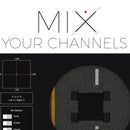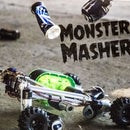Introduction: RC Fireworks Truck
My co-worker Tom recently made an RC Army truck and I liked his project a lot... but I felt like it needed a little something... some firepower! So I asked him if I could add some remotely ignitable fireworks on a pan & tilt system, and of course he agreed.
Step 1: Parts List
This is what we used.
- Fireworks!
- wood and paint for the body
- 3 - 4.3" Off-Road Robot Tires (595650)
- 3 - Black Robot Wheels (595652)
- 6 - 110 RPM Micro Gear Motors (638110)
- 6 - Micro Gear Motor Enclosures (555120)
- 6 - 12.0" Heavy Duty Hitec Battery Leads (BL2212S)
- 6 - Lightweight Set Screw Hub w/ 3mm Bore (545348)
- 3 - 12mm Hex Hub Wheel Adaptor (2 pack) (545432)
- 1 - 18v7 Simple Motor Controller (605060)
- 1 - Optic 5 2.4GHz TX w/ Minima 6E RX (SC807002)
- 2 - 1.2V 4400 mAh NiCad Battery (KR-4400D)
- 3 - 6.0V 2000mAh NiMH Battery (HCAM6351)
- 1 - SPT200 Pan & Tilt Kit (SPT200H)
- 2 - HS-5485HB Servo (35485S00)
- 1 - Traxxas Glow Plug (3232X)
- 1 - RC Switch (605090)
- 2 - 1.25” Rubber End Cap (9753K65)
- 2 - 1.25” Rubber End Cap (Tall) (9753K66)
- 2 - 32mm Bore Bottom Tapped Clamping Mount (555176)
- 3 - Flat Triple Pattern Bracket (585580)
- 2 - 1" Bore, Face Tapped Clamping Hub (545352)
- 2 - Beam Attachment Blocks B (4 pack) (585600)
- 1 - 4.5” x 6” Aluminum Pattern Plate (585002)
- 1 - 0.25" Bore Face Tapped Clamping Hub (545588)
- 1 - Wired Male Tamiya Connector (E1073)
- 1 - Wired Female Tamiya Connector (E1074)
- 1 - HS-311 Servo (for steering) (31311S00)
- 1 - Beam Attachment Blocks A (4 pack) (585403)
- 2 - Standard Servo Plate C (575144)
- 1 - 1.54" (5 hole) Aluminum Beams (2 pack) (585404)
- 5 - Beam Bracket F (2 pack) (585612)
- 1 - 2.31" (7 hole) Aluminum Beams (2 pack) (585406)
- 1 - 6.16" (17 hole) Aluminum Beams (2 pack) (585416)
- 2 - 12.32" Mini Channel (585399)
- 2 - 1.54" Mini Channel (585380)
- 1 - 2" 6-32 Round Aluminum Threaded Standoffs (4 pack) (633146)
- 3 - 3.85" (11 hole) Plastic Beam (585668)
- 1 - 2.31" (7 hole) Plastic Beam (585664)
- 1 - 1.54" (5 hole) Plastic Beam (585663)
- 1 - 308SH Long Single Servo Arm (308SH)
- 1 - 4" Male to Male Servo Extension (MM2204S)
- 1 - 12" Male to Male Servo Extension (MM2212S)
- 3 - 12" Hitec Super-Duty Servo Extension (SE2212S)
- 1 - Double Header Row Pin (HPD-100-72)
- 1 - 6.0" Standard Hitec Battery Lead (BL2406S)
Step 2: Create the Cab & Bed
Tom used wood for the cab and bed of the truck and painted it army green. You could also design and 3d print the bed & cab if that is more your speed.
The bed is approximately 7" x 14.25".
The cab is about 7.75" long, 6.25" tall and 6.125" wide.
Tom also fashioned a bumper out of ABS plastic. This could just as easily be made of wood as well or 3d printed.
Step 3: The Drive System
Motors and Wheels:
It is a 6 wheel design and each wheel has its own 110 micro gear motor. They have surprising torque for their size. Each motor has a set screw hub attached to a hex adapter. Each hex adapter it used to mount a hex hub wheel.
Front:
An HS-311 servo steers the truck via a servo arm and some plastic beams. The servo is mounted so that it (and the whole front wheel assembly with it) will swivel (roll) to help the truck traverse rough terrain.
Rear:
The four rear wheel/motor assemblies are divided into the left two and right two. Each side swivels (pitch), pivoting between the two wheels on that side via some beams.
Control:
Two of the RC channels control the drive system. One channel controls the steering servo directly. Another channel goes into a motor controller. The PWM signal is interpreted by the motor controller to determine the speed of the motors. All six motors tie into the motor controller.
Step 4: The Launcher
Aiming:
At it's core the launcher is an SPT200 pan & tilt kit. This allows us to aim our fireworks where we want. It is powered by two HS-5485HB digital servos. The nice thing about using digital servos is that we were able to use a servo programmer to tune the range of travel.
Firing:
My favorite part of this project is the ability to remotely ignite the fireworks by hitting a button on the side of the transmitter. We used a Traxxas 3232X glow plug which is normally used in internal combustion engines of RC cars. It requires 1.5V. This was my first time working with RC glow plugs and I did some research ahead of time and found that you don't want to send too many volts or else you will burn it out. I found that to be very true when I sent it about 2.4V and burned one out in about a second. I also learned via testing on a benchtop power supply that these little guys will suck down 4 Amps at 1.5V. Since step-down voltage converters that will go down to 1.5V and can handle 4A are rare I decided to use a 1.2V NiCad battery. I ended using two wired in parallel for symmetry (which also increased the longevity).
The glow plug is mounted inside of a 1/4" hub mount. We learned that close is not good enough, the fuse needs to actually touch the glow plug coil to ignite. So we used a small aluminum tube to act as a guide for the fuse as well as provide wind protection. This combination worked out great! However we did need to remove ash from the bore of the tube when loading another round to prevent it from building up and blocking access to the glow plug coil. A child's pipe cleaner worked out well.
The glow plug is triggered by an RC mosfet switch. The RC switch is connected to the RC receiver and when I click the button on my transmitter it makes that channel exceed the PWM threshold that the RC switch is set at which then tells the switch to turn on the glow plug.
Step 5: Power and Wiring
Glow Plug Power:
I already discussed how the glow plug is a picky eater and so giving it its own power supply worked out well. Especially because it acted as a counterbalance to offset the weight of the fireworks. I also used some rubber end-caps to cover the glow plug's batteries to make them look more like air, fuel, or oil tanks.
Servo Power:
To power the receiver, pan & tilt servos and steering servo, I used a 6V NiMH battery.
Drive Power:
I wanted to run the drive motors at 12V to get more speed and power. I connected two 6V NiMH batteries in series to get the 12V I was after. I could have used a step-down voltage regulator as a BEC to bring this down to 6V for the receiver and servos instead of having another battery. I happened to have another battery so that is the route I chose, either way would work.
Step 6: Light It Up!
Once you've built your rig, tested your electronics, tuned your servos, and have your igniter glowing on command, it is time for some fun!
I recommend having a spool of fuse, long and short zip ties and some side cutters on hand when it is time to light it up. The spool of fuse will come in handy to extend the length of your fireworks' fuses to reach the glow plug. The small zip ties can hold the fuse extension to the stock fuse. The large zip ties can hold the fireworks in place on the launch pad.
'Merica







![Tim's Mechanical Spider Leg [LU9685-20CU]](https://content.instructables.com/FFB/5R4I/LVKZ6G6R/FFB5R4ILVKZ6G6R.png?auto=webp&crop=1.2%3A1&frame=1&width=306)





